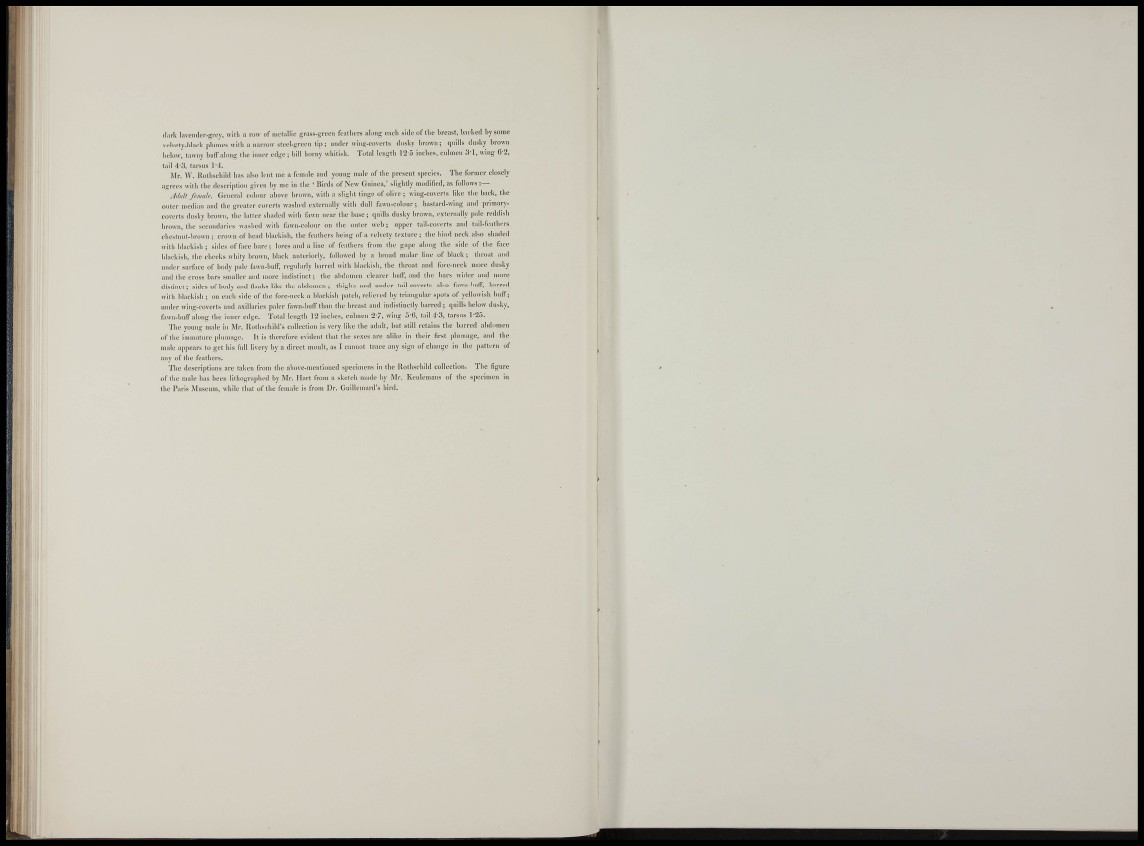
(liii-li l;ivcii(ler-giTy, with a row of luctiillic grass-grcLMi featlicrs along each side of the breast, bat-kcd by some
velvety-black plumes with a narrow steel-green tip; under wiiig-eoverts dusky brown; quills dusky brown
below, tawny buifalong the inner edge; bill boriiy whitish. Total length 12 5 inches, culmen S' l , wing G'2,
tail 4-;i, tarsus I'-l.
Mr. W. liothschild has also lent me a female and young n¡ale of the present species. The former closely
a g r e e s with the description given by me in the ' Bi rds of N e w Guinea,' slightly modified, as follows : —
Adull fcmuk. General colour above brown, with a slight tinge of olive; wing-coverts like tlie back, the
o u t e r median and the greater covcrts washed externally with dull fawii-colour ; bastard-wing and primaryc
o v e r t s dusky brown, the latter shaded with fawn near the base ; quills dusky brown, externally pale reddish
brown, the secondaries washed with fawn-colour on the outer web; upper tail-eoverts anil tail-feathers
c h e s t n u t - h r o w n ; crown of head blackish, the feathers being of a velvety texture ; the hind neck also shaded
with blackish ; sides of face bare; lores and a line of feathers from the gape along the side of the face
blackish, the cheeks whity browi), black anteriorly, followed by a broad malar line of black ; throat and
u n d e r surface of body pale fawn-bnlf, regularly barred with blackish, the throat and fore-neck more dusky
and the cross bars smaller and more indistinct; the abdomen clearer hulf, and the bars wider mid more
d i s t i n c t ; sides of body and flanks like the abdomen ; thighs and under tail-coverts also fawn-hulf, barred
with blackish ; on each side of the forc-ncck a blackish patch, relieved Ijy trimigidar spots of yellowish bnlf;
under wing-coverts and axillaries paler fawn-bnlf than the breast and indistinctly barred ; quills below dusky,
fawn-bulf along the inner edge. Total length 12 inches, culmen 2-7, wing 0'(i, tail 4-3, tarsus 1-20.
'I'he young male in Mr. Uothschild's collection is very like the adult, but still retains the barred abdomen
of the immature plumage. It is tbcrcfore evident that the sexes are alike in their first plumage, iind the
male ajipears to get his fnll livery by a direct moult, as I catmot trace any sign of change in the ])attern of
any of the feathers.
T h e descriptions are taken from the above-mentioned specimens in the Rothschild collection. Tlie figure
of the male has been litliograplied by ¡Mr. Har t from a sketch made by Mr. Kenlemans of the specimen in
t h e Paris Museum, while that of the female is f rom Dr . Guillemard's bird.